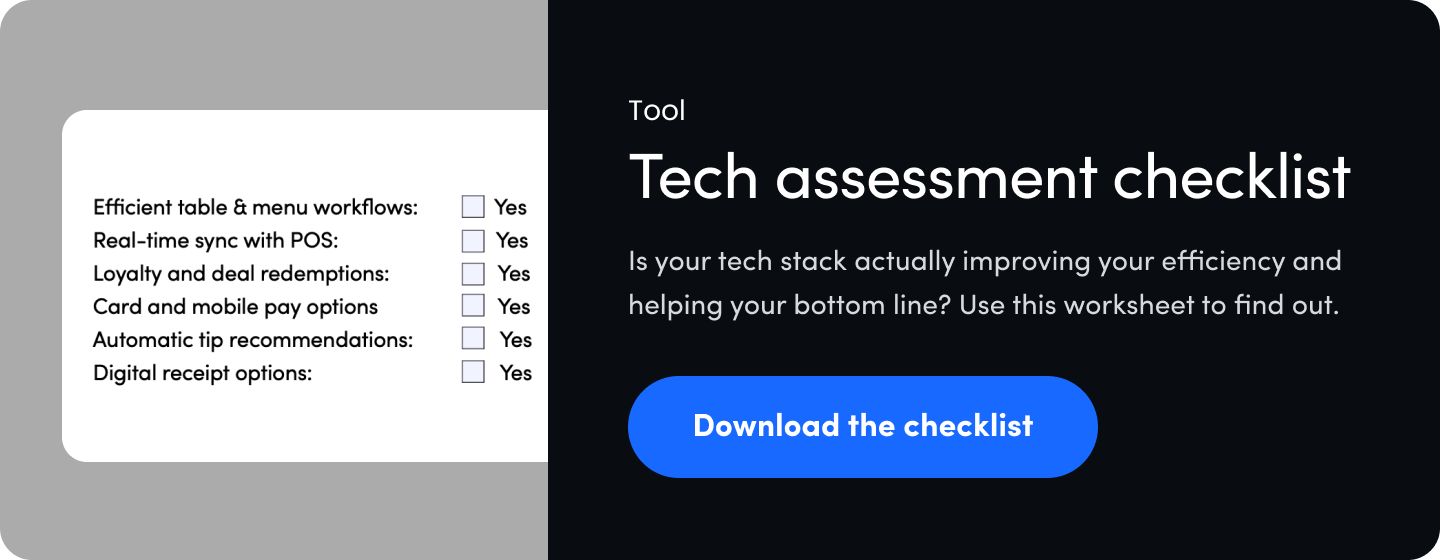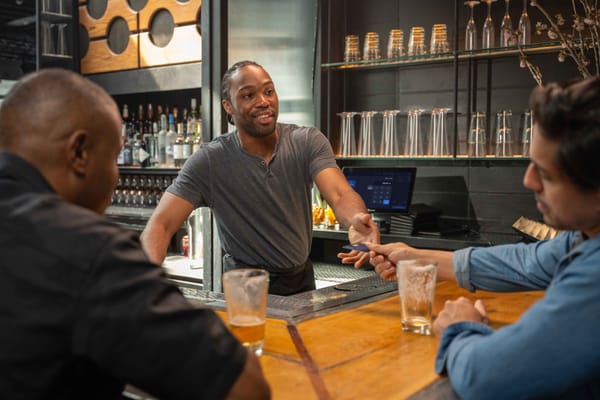It all starts with a cheeseburger. It's a double, with extra caramelized onions, avocado, sub cheddar for Swiss. No mayo, hold the tomatoes. The server just onboarded last week and didn't know which is a modifier versus an add-on versus something he'll have to run by the kitchen staff first.
The rest of the table is patiently waiting their turn, but the special burger is taking up so much of my time, so I just need to get their orders as quickly as possible and move on to my next table. Not to mention, I've just been scribbling the order in chicken scratch on a notepad, which I'll then take another 4 minutes to plug into the restaurant POS system (if it's decipherable, that is).
Over my 25 years in the restaurant industry, I've seen how restaurant technology has changed the ordering process. When it's done right, it can turn good servers into great ones, refine the guest experience, and help make everyone more money. When it's not, it's a distraction at best and a stain on the staff and guest experience at worst.
If you believe that restaurant tech, like handheld POS systems, takes something intangible away from the guest experience, chances are you're not using them the right way. Whether you're running a neighborhood dive bar, a slammed patio, or a fine dining concept, here are my foolproof tips for incorporating handhelds into your service model.

1. Have a great conversation
This tip isn't related to the tech at all. Hang out at the table and connect with your guests. Talk about things all over the map: local events, live music, the new botanical gin from the craft distillery, whatever helps you build a rapport. That's what converts first-time guests into regulars.
In the typical restaurant flow, you might think, "How quickly can I get away from this table?" You've got to walk 75 feet to the nearest POS station, and you've already noticed that table seven is due for another round. It can add a franticness to the dining room that rarely results in a great guest experience, let alone better tips.
The best part about handheld service is that it lets servers spend more time with their tables. When you have a real conversation, you're more likely to remember the guests and vice versa. As a server, just knowing that you can place orders—and see them come out of the kitchen—faster relieves you from that rushed feeling and gives you the breathing room to actually engage with your guests.
2. Get the drinks flowing
It's not revolutionary, but it is important. You want to get your table's drinks in as soon as possible. The sooner you get that first round in, the higher the likelihood they'll have time for another, leading to better service (and tips).
Walk your guests through the drink menu, understand their preferences, and then take a beat to fire those orders using the handheld. With a well-set-up menu screen and thoughtful modifier flow, it will take seconds to place a few specialty cocktails and bottled beers.
Firing the drink order as quickly as possible gives you a beat to explain the appetizers and the rest of the menu. You can take full advantage of the minutes you'd spend walking to the POS and instead focus on menu description and upsells.
3. Confirm the order (and modifications) as you go
Whether you're scribbling down an order or relying on memory, placing the order at a POS station means you can't triple-check that special order and make sure it's just right. Your guest wants the craft cocktail made not too sweet, or with extra basil, or with a sugar substitute. You have the chance to confirm their preferences and deliver a drink that's exactly to their liking.
With handwritten orders, you're writing so fast that it's scribble. Then you've got to leave the table, stop by your other 6 or 7 tables, and by the time you finally get to the POS, you're struggling. You can't quite remember a modifier, but you fire it anyway, and once the original table gets their meals, there are tomatoes where there shouldn't be and extra mayo instead of no mayo. It can't be salvaged. It's a misfire for the kitchen and a bad look for you as the server.
4. Use the menu information
Ideally, you know everything about every ingredient and dish on the menu. But especially if you're a new server, it's just not possible. Thankfully, menu descriptions have your back. When you're using a handheld, tap an item, then go to the menu item info. If your menu is configured properly, you can find everything from a picture of the item to the portion size to the origin story of the steak in question.
Full descriptions are particularly powerful when it comes to the wine list. If your restaurant has an extensive wine list, handhelds provide an amazing source of reference.
There have been so many times that I've worked in a restaurant, and I haven't tried everything on the menu—I definitely haven't tasted that really expensive bottle of wine. Using the handheld can help you say, "Yes, the 1998 Caymus Cabernet, Napa Valley. It's got hints of dark chocolate, toasted macadamia nuts, cherry tomatoes, bing cherries, and a silky texture. It pairs really well with that steak." Now, you look like an expert. And if the bottle is $400, that's going to make a difference for your bottom line.

5. Make it easy to split
For guests and servers alike, splitting the check can be a headache-inducing experience. Handhelds take the stress out of this process since you can stand there and confirm who is paying for what, make sure you've got it right, and proceed immediately to payment. If your guests are splitting it four ways, it's one button to split, and your guests can pay with American Express, a gift card, or an Apple watch—it's equally as easy.
You can print the check if your guests want paper copies or text or email it to their phones if they've gone digital. Most importantly, when servers have their own handhelds, you're not tying up the POS station with an elaborate split configuration while your fellow server needs to put her apps in.
6. Respect your customers. Don't stress the tip prompt.
Tip prompt screens have been getting a bad rap as they've expanded outside of restaurants. Tiplflation aside, creating a positive tipping experience is simple.
Hand your guest the handheld, or hold it at the guest's level and turn your head away. A lot of servers will do the hard play and sit there and stare at the guests, which isn't cool. You've already given a great guest experience and nailed those upsells, so why make the experience uncomfortable? Trust in the work you've already put in.
At the end of the day, your customers are going to give you whatever they give you. On the off chance they don't leave a tip at all, you can check in and see if there's anything you can do differently next time or if the guest has any feedback. It might be an error on their end. Some people are just not going to tip you. I think the best way is to move on instead of making things uncomfortable. It's a numbers game, after all, and you can shrug it off and try to do the best you can with your remaining tables.
7. Save even more time with Quick Send
As a server, those nights where you're slammed with guests from open to close can be a blessing or a curse (and sometimes, both). If you have the right support staff and you're set up for success, it's a big payday. If you're not, it's the kind of shift that makes you question everything.
On these nights, the Quick Send button on your handheld is huge. It helps you fire orders immediately, so you don't have to waste a second. This is your secret weapon for getting drinks to the bartender as soon as possible, handling large parties, and making sure your kitchen isn't crushed with orders during peak service.
It's not just about doing more with less, it's that if you don'tit's have this tool in your arsenal, there's a high chance you're going to bomb. With a handheld, you have a fighting chance.
8. Why not dessert?
Dessert can cause some hesitation—your table seems like they're ready to leave, and, as a server, it's easy to feel the urgency to close out and move on. But dessert is key to higher check averages. If I can get just one cheesecake split between a table of four, it's $10. But if I have 20 tables, and I can get a cheesecake down for half of them, that's $100. I'm working five days a week, so it's $500 per week or $2,000 a month. One cheesecake per table could add an extra $24,000 to the restaurant's revenue. Those are just simple numbers.
Having the flexibility to get to your table at the right time, once the meal is finished but before they're fully sated, can help push your dessert numbers (and make everyone's lives a little sweeter).

A tough job made easier with tech
Servers don't have it easy. Sure, taking on a handheld POS system means adapting your service style and getting acquainted with a new device. But in the long term, if technology allows you to make more money with less stress, it's hard to justify returning to scrawling on a notepad and expending wasted steps. With the right technology and a few tips, a little screen time can go a long way.
Meet the author
Greg Svitenko has over 25 years of experience in the restaurant industry, having worked his way up from barback to mixologist to Assistant GM and GM at multiple restaurant concepts. He created several cocktail programs and was selected by Ketel One as one of the "Top 25 Bartenders in the US", among other awards. He also owned his own restaurant for two years.
As a Senior Manager of Sales Operations at SpotOn, he works with new clients and trains SpotOn employees on how to leverage technology to streamline restaurant operations and improve profit.













